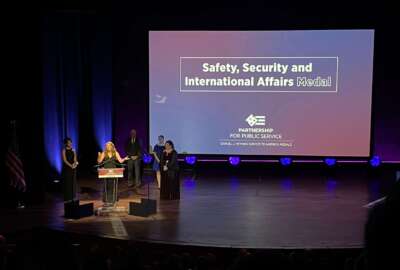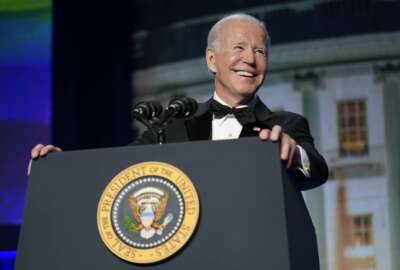
It’s time to celebrate some of the government’s best and brightest
Finalists for Service to America Medals, known as the Sammies. It's a signature program of the Partnership for Public Service.
Each year we turn to celebrate some of the most capable and accomplished career federal civil servants. Finalists for Service to America Medals, known as the Sammies. It’s a signature program of the Partnership for Public Service. Federal Drive with Tom Temin got a preview on the Sammies with Partnership President & CEO Max Stier.
Interview Transcript:
Tom Temin And every year the Sammies do manage to inspire because, you know, out of a workforce of a couple of million, there are really some amazing people. And so there’s never a shortage of candidates. This year, just give us a sense of the breadth of the nominations, where they came from and what does it look like?
Max Stier So you’re right, there is no shortage of amazing stories. You have 2 million people and you have the responsibility of our federal government to handle the full range of challenges that we face as a country. So you have everything this year from things that are on top of news, like the response to the Russian invasion of Ukraine or, you know, major investments that we’re making. The bipartisan infrastructure law actually requires that enormous amounts of implementation that the people, the Department of Transportation and elsewhere are actually implementing. So you cover issues like that, but you also cover issues that are less well understood. A wonderful couple of young federal employees who are part of the critical team that is dealing with trying to get hostages back from other countries. And really incredible work that they are doing, or longtime issues such as how NASA deals with risk and understanding how to create a culture that both is able to innovate and ensure that we have safety. So the issues are broad and meaningful in all aspects of our society, and we have incredible people that we should be celebrating.
Tom Temin Over the years, some of the ones that have impressed me that I’ve interviewed and I’ve been covering this now for almost, well, how far do they go back? About 20 years now, right?
Max Stier Correct.
Tom Temin Since you were in Union Station presenting way long time ago. But two that stand out in my mind or one was someone from the National Transportation Safety Board, now retired, who had figured out the cause of a TWA flight that burst into flames, Flight 800. And the other one was the FBI agents who many, many years later, decades later solved and brought to justice the people involved in the Birmingham, Alabama, church bombing back in the 1960s. Those people were still around and they were brought to justice. The theme there is just dogged determination and never wavering from the mission, no matter how long it takes.
Max Stier Yes. There are many, many, many highlights. One of the things that I find always quite remarkable is, you know, we’ve announced our finalists and we’ll have a gala in the fall for the so-called winners. They’re all amazing. And really to distinguish between the 27 that are honored here and then the six that get recognized in the fall, they’re all incredible, amazing, wonderful, whatever adjective you want to use. And the American people should be grateful to have that kind of service. You know, there are a lot that stand out for me. Very early on, the woman who started the Do Not Call registry, which, you know, obviously we’re in a slightly different world now, but for a very long time it meant that literally hundreds of millions of Americans could have their meals and peace without their phone ringing. You know, the gentleman who helped eradicate polio in India. Then you have people like Tony Fauci, who clearly are extraordinary heroes. But two of his colleagues that, you know, were the designers of the vaccine that has kept so many, many, many Americans safe. So it’s just amazing the breadth of accomplishment. And we need to both appreciate and invest in our government so we can deal with future problems.
Tom Temin We’re speaking with Max Stier, president and CEO of the Partnership for Public Service. And for those that might be learning about this for the first time, the new generation coming in that 9% of feds under 30, just review the history of the program. Samuel Hammond’s part in it, the late Samuel Hayman, and how this whole thing came to be.
Max Stier So we’re 22 years old as an organization. This is one of the first things that we did. And we also set up a coalition of universities to try to get talent in the government called Call to Serve, which is now 700 universities and best places to work was pretty early on, too. But we set this up. It was actually just the Service to America medals, not the Samuel J. Hayman Service to America Medals. Sam was our founder. 22 years ago, he decided that this is where he wanted to help the 1.5 million non-profits out there, and we’re pretty much it that does this work. They’re all doing important work on policy lanes. Our view is you get the government to do better and you actually help in all those areas that they’re working on. He passed away a little over, I think, 13 years ago, and we decided as a way of honoring him that we would name the program in his name and the Sammy’s and Sam, so that obviously worked out pretty well in terms of alignment. But the concept was originally to create a program that honored federal employees as a mechanism of telling their stories to the public. And what we learned is that it actually had two very powerful purposes. The first, educating the public about what our government employees are doing. But equally important, was really trying to create a recognition culture inside of government. And our understanding about how important that is has grown over the years. The FEVS, the best places, looks at that question about do you believe your good work is recognized and it’s just not high enough in the federal government. I think we believe organizations get better faster by focusing a lot of attention on what’s good that can be replicated. I think it’s true with kids as well. Positive reinforcement is more powerful than the negative. You want to identify problems, but you want to find the solutions. And those solutions are there, they’re just not they’re not actually pulled up and communicated in a way that allows others to learn from them.
Tom Temin And this is a rolling program because you’ve got to keep that feedstock coming in so anyone can nominate anyone. How does the nominations work in case people say, hey, this person here deserves this?
Max Stier Yeah, and thank you for raising that. The answer is that we will open up nominations for next year immediately following the announcement of the current winners. So this will be in mid-October, October 17. And as you just suggested, anyone can nominate. We don’t take self-nominations anymore. We’ve actually had some very good self-nominations, just better from our end because we do a lot of due diligence to check out and we actually engage the former honorees in doing that due diligence since they know the government best. I will note that sometimes people are loathed to nominate someone because they’re like, oh, there’s no way they’re going to beat someone who eradicated polio in India. And my recommendation is, don’t worry about whether you think someone is going to win or be a finalist. Nominate someone who you just think has done an amazing job. It’s a vote of confidence in them, it’s meaningful to them. And irrespective of what happens next, and I actually have seen a lot of federal resumes that say nominated for Sammies. And it’s a way of just saying thank you. So please have at it. It’s really great to see the variety of stories and we try to use those stories in other places even beyond Sammies.
Tom Temin Right. I think a lot of the general media that knows the politics of government, but they don’t really understand the operations of government, that’s helped educate them, too. And I also want to draw a distinction between the Sammies and the Presidential Rank Award program. That’s only open to senior executive service members, of which there are, what, 15,000 or so, roughly.
Max Stier Closer to 7000 for SES. But yes, you are you are correct on the distinction between the rank award, which is phenomenal and important and determined inside a government. We’re doing this from the outside. And, you know, our focus is really on the concrete impact that it’s had on the public. Someone, someone or some teams, you know, work. My view is the more the better. Like there are other recognition programs. We would love to see more of them. We we have again, a deficit of recognition in our government. So there are other programs out there that we support.
Tom Temin But besides the distinction that the Sammies are available to any federal employee, not just SES-ers, there’s also the fact that you have this big program around it. You’re talking to me and, you know, we go to the gala and as you know, the Federal Drive interviews, as many as we can fit in between now and the awards ceremony. The Presidential Rank Award program, the White House puts out a PDF with a list of names. You have no idea what the people did or who they are, just where they work. And I think that seems like an opportunity that they could take some, let’s put it this way, inspiration from how the Sammies are handled.
Max Stier Well, I mean, I think it’s an important point that you raise. I think our government could do better in telling the stories of its achievements. And it’s, you know, can be tricky. The politics of that can be tricky. But the reality is that the public needs to hear about the great work that their federal employees are doing. And agencies, some do more in the way of investment and trying to tell those stories. We need to see even more of it. In our research, one of our focuses now is the public’s distrust of our government. And what we have found is that when you say federal government, people think about bickering politicians in Washington, they don’t actually think about the 2 million career civil servants, 85% or so that are outside of the D.C. metro area. And they don’t think about the people that we’re honoring and Sammies. So we need to communicate those stories so the public really understands, you know, who their government actually is and the distinction between those bickering politicians and the professionals that, you know, are dedicated, you know, often for their full career to serving the public. So we are keenly interested in having those stories told. And we appreciate all that you’ve done in getting the message out.
Copyright © 2025 Federal News Network. All rights reserved. This website is not intended for users located within the European Economic Area.
Tom Temin is host of the Federal Drive and has been providing insight on federal technology and management issues for more than 30 years.
Follow @tteminWFED
Related Stories





